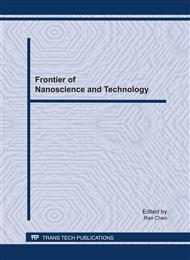[1]
Xiushan Gao: Thermal power plant cooling water treatment [M]. Beijing: China electric power press, ( 2001), pp.27-41, 82-86.
Google Scholar
[2]
Bensheng Zhou: Industrial water treatment technology [M]. Beijing: Chemical industry press, (2002), pp.42-52, 235-253.
Google Scholar
[3]
Lei Wu: Cooling water system evaluation method of scale inhibitors. Industry and engineering progress, 21(4), pp.275-277. (2002).
Google Scholar
[4]
Yunzhang Cheng: Scale inhibition mechanism and performance evaluation. East china electric power, pp.14-18. (2003).
Google Scholar
[5]
Y Ning Robert: Complete elimination of acid injection in reverse osmosis plants[J]. Desalination, pp.29-34. (2002).
DOI: 10.1016/s0011-9164(02)00218-7
Google Scholar
[6]
XUE Ke , YANG Qingfeng: Dynamic evaluation methods for anti-scalants in reverse osmosis systems. CHEMICAL INDUSTRY AND ENGINEERING PROGRESS. 25 (8). (2006).
Google Scholar
[7]
Choi Dongjin, Jae Seung: Development of an environ-mentally safe corrosion, scale, and microorganism in-hibitor for recirculating cooling systems[J]. Materials Science and Engineering, 335, pp.228-236. (2002).
DOI: 10.1016/s0921-5093(01)01928-1
Google Scholar
[8]
Drak A, Glucina K: Laboratory technique for predic-ting the scaling propensity of RO feed waters[J]. De-salination, 132, pp.233-242. (2000).
DOI: 10.1016/s0011-9164(00)00154-5
Google Scholar
[9]
Hansson D, Bramson D, Limoni-Relis B, et al: In-fluence of the flow system on the inhibitory action of CaCO3scale prevention additives[J]. Desalination, 108, pp.67-79. (1996).
DOI: 10.1016/s0011-9164(97)00010-6
Google Scholar
[10]
Heqing Tang, Songqiao Qi, Huimin Guan, Li Youqing: Variations of concentrations of precipitable ions during precipi-tation of CaCO3 and a new method for evaluating scale inhibitors, Huazhong University of Science and Technology Report, 10, p.35. (2007).
Google Scholar
[11]
I. Drela, P. Falewiez, S. Kuezkowska: New Ra Pid Test for Evaluation of Seale Inhibitors[J]. TeelmiealNote, 32, p. 3188一3191. (2002).
Google Scholar
[12]
Dong-Jin Choi, Seung-Jae You, Jung-Gu Kim: Development of anenvironmentally safe corrosion, scale and microorganism inhibitorfor open recirculating cooling systems[J]. Materials Science&En-gineering A, 335, pp.228-236. (2002).
DOI: 10.1016/s0921-5093(01)01928-1
Google Scholar
[13]
A. Neville, A. P. Morizot: A combined bulk chemistry electrochemical approach to study the precipitation, depo-sition and inhibition of CaCO3[J]. Chemical Engineering Science, 55, p.4737. (2000).
DOI: 10.1016/s0009-2509(00)00046-4
Google Scholar


